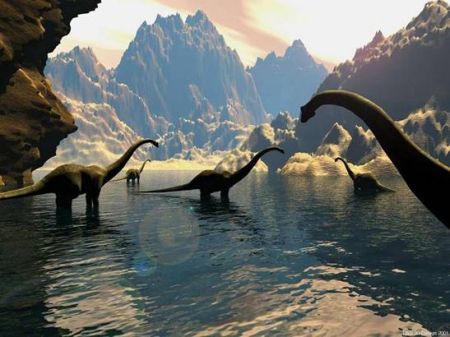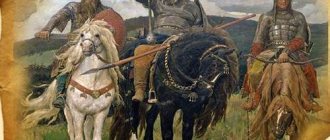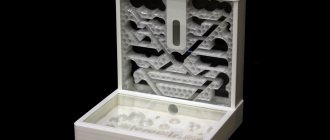Research project “The Amazing World of Dinosaurs”
Sofia Fartushnaya
Research project “The Amazing World of Dinosaurs”
Introduction
Millions of years ago, long before man appeared on Earth, dinosaurs . I think you will agree that dinosaurs are the most amazing of all creatures that lived on our planet; they still excite people’s imagination and arouse their keen interest, especially among children. In my opinion, this is a very interesting topic.
Paleontologists have long debated when dinosaurs . When did dinosaurs and why did they disappear are questions for which there is no clear answer. Many questions about the life of dinosaurs still remain a mystery to us.
The relevance of the topic is that this is the past of our planet, and in order to look into the future, we need to know our past. I decided to find out everything about dinosaurs , the time when they lived and, of course, the reasons for their extinction. Suddenly, knowing these reasons, it is possible to prevent the extinction of other animals in the future. In the lessons of the surrounding world, we study the life of animals, and the materials from my work will be useful to elementary school students.
I became interested in dinosaurs At home we have an encyclopedia about dinosaurs . At first I just liked looking at colorful pictures, and when I learned to read, little by little I began to study dinosaurs , which I like most. I watched films and cartoons about dinosaurs , collected collections of toy dinosaur .
I decided to find out if my classmates knew about dinosaurs and if they were interested in this topic. To do this, I compiled a questionnaire that contained the following questions:
1. Who are dinosaurs ?
2. What time did you live in?
3. What did you eat?
4. What happened to them?
5. The reason for their death?
After conducting a survey in my class, I concluded that only 15 people have superficial knowledge about dinosaurs , and the rest have simply heard about them. But all classmates answered that this topic was interesting to them, and they wanted to learn more about dinosaurs . After that, I started working on the project .
Hypothesis: If you study the life of dinosaurs and the reasons for their death , you can expand your horizons, interest your classmates in the distant past of our planet, and learn to treat nature with care.
Goal: study the life of dinosaurs (who they are, their types, what they ate, what time they lived)
and the reasons for their death.
Tasks:
— conduct a survey among classmates to identify knowledge about dinosaurs ;
— find sources of information about the life and death of dinosaurs and study them ;
— make a model of the life of dinosaurs ;
— assemble a model of the “Diplodocus skeleton”
;
- assemble from Lego
Tyrannosaurus;
— create a filmstrip “ Dinosaurs ”
;
-tell your classmates about the distant past of our Earth and the disappeared world of dinosaurs ;
Methods:
1) study of literature;
2) survey;
3) practical work (simulation)
;
4) analysis of the collected material;
Dinosaurs - who are they??
These amazing animals lived more than a hundred million years ago, long before the advent of man. Now imagine that you and I are in that time. The Earth would have seemed inhospitable and scary to us in those days. Dinosaurs are everywhere - large and small, peaceful and predatory, slow and fleet-footed, on two or four legs. Oh, how scary! It's hard to imagine how we would exist next to them!
English scientist Richard Owen (1804–1892)
found a large number of huge bones.
The animals whose skeletons he discovered seemed very scary to him, and he called them “terrible lizards
,” or
dinosaurs .
Since then they have been called that. " Dinosaur "
translated from Greek as
“terrible lizard”
.
There were over 1,000 different species of dinosaurs .
Dinosaurs that lived on Earth were numerous and varied. Some were huge, others were very tiny. Some had smooth skin, others had scaly skin, and others even had a horny shell protecting the body. In addition, some had horns or spikes. Dinosaurs lived both on land and in water and air - sea and flying reptiles. Some were carnivores, eating meat, while others were herbivores, eating only plants. Some of these reptiles were harmless, others were ferocious predators.
What did dinosaurs ?
All living beings need food. From it they receive the energy and nutrients necessary for life, growth and reproduction. Depending on their feeding methods, dinosaurs can be divided into two groups: herbivores and carnivores.
Herbivorous dinosaurs ate any vegetation they could reach. They had large, flat teeth with cutting edges that were ideal for chewing rough plant foods. Small dinosaurs ate roots and low-growing plants, and the largest ones reached the leaves of the crown, rearing up to do this. (Stegosaurus, Euoplocephalus, Ankylosaurus, Brachiosaurus, Diplodocus, Apatosaurus, Triceratops, Iguanodon, Hadrosaurus, Argentinosaurus, Sauropod, Parasaurolophus, Gigantosaurus, etc.)
Carnivorous dinosaurs were powerful animals that ate only meat. Their teeth were long and sharp, like knives. With their help, they easily tore prey into pieces and cut off pieces of meat suitable for swallowing. They walked upright on their hind legs. Their forelimbs were much shorter and ended in clawed fingers, with which they killed their prey.
(Velociraptor, Spinosaurus, Tyrannosaurus, Dilophosaurus, Compsognathus, Ornithomimus, Triceratops, Allosaurus, etc.)
How did dinosaurs ?
Dinosaurs , like other reptiles, reproduced by laying eggs. Found nests prove that dinosaurs cared for their offspring. The most devoted parents were hadrosaurs, diplodocus and ceratopsians. Some female dinosaurs laid their eggs in sun-warmed sand and buried them. Other females laid them in a specially built nest: they made a mound of loose earth, after which they laid the eggs in a depression at the top, the eggs were covered with a layer of rotting leaves, stems or grass so that they remained in warm until the babies hatch. The female built the nest where the eggs would be warm and safe.
Dinosaur eggs were of different shapes - round, elongated or oval - and of different sizes - some were tiny, the size of a tennis ball, others large, the size of a football. The shells of the eggs were calcareous, dozens thicker than those of a chicken. It was leathery and flexible, not hard and fragile like a bird's. dinosaur egg had the same internal structure as a chicken egg. dinosaur embryos matured inside the eggs thanks to the heat generated by the plant material used to build the nest. When the cubs grew to such an extent that they could already exist outside the egg, they pierced the shell from the inside with an “egg tooth”
(a hard outgrowth on their face)
and hatched out.
Some cubs lived in the nest with their parents until a certain age; for the first weeks of their lives, they were constantly protected and fed by the female. Other cubs, as soon as they were born, left the nest and began to live independently, without needing the help of adults. The cubs grew very quickly. As they grew older, their growth slowed down, but did not stop. Dinosaurs grew until the end of their lives. It is believed that the lifespan of small dinosaur was approximately 10 to 20 years. Giant dinosaurs could live between 200 and 300 years.
Characteristics of the most famous dinosaurs
Let's look at the most interesting representatives of dinosaurs .
Tyrannosaurus is the most predatory dinosaur . Tyrannosaurus is translated as "royal lizard"
or
"tyrant lizard"
.
It reached 15 m in length and up to 5.5 m in height, and its body weight was up to 7-10 tons. It hunted smaller representatives of the animal world and did not hesitate to attack its own kind. Could swallow a small dinosaur whole .
He did not hesitate to profit from carrion. Tarbosaurus is a bloodthirsty predatory dinosaur that lived during the late Cretaceous period. Tarbosaurus means "frightening lizard"
.
Tarbosaurus is about 12 m long, 6 m high, weighs up to 6 tons. He hunted absolutely all dinosaurs , including even his own kind, the main thing for him was only one thing - to find a victim and eat it.
Tarbosaurus did not refuse carrion, or even fish. Velociraptor is one of the smallest predatory dinosaurs that lived in the late Cretaceous period. Velociraptor means "fast thief"
.
His weight was about 20 kg, his height was 60 cm, and his body length did not exceed 2 m. He hunted all dinosaurs , very often the victim was significantly larger than him in size, but with the help of his sharp sickle-shaped claws he tore her cervical arteries, trachea and veins .
Diplodocus is a herbivorous dinosaur , one of the largest. The most peaceful and harmless creature. It reached 35 m in length, 10 m in height, and weighed about 38 tons. Diplodocus had a long neck and tail. He ate only vegetation. A copy of the Diplodocus skeleton is in the paleontological museum in Moscow.
A close relative of Diplodocus is Seismosaurus - “earth-shaking lizard”
. The earth must have hummed and trembled under the weight of his paws. It was not always easy for such giants to move on land, so some spent a lot of time in the water, where it was much easier to walk on the bottom and chew algae.
Brachiosaurus is a herbivorous dinosaur that lived at the end of the Jurassic period. Brachiosaurus translates as "shouldered lizard"
.
The body length was up to 26 m, it could reach 13.5 m in height, and weighed 50 tons. Brachiosaurus was one of the largest and tallest dinosaurs .
It fed on vegetation, its long neck allowing it to reach the treetops. Iguanodon was a herbivorous, duck-billed dinosaur that lived during the early Cretaceous period. Iguanodon means "iguana tooth"
. Iguanodon reached a length of 10 m, a height of 5 m and weighed almost 5 tons. The distinctive features of the iguanodon were clawed limbs and a strong beak, similar to the limbs and beak of a bird. Iguanodon ate mainly only leaves from trees and bushes.
Saurolophus was a herbivorous, duck-billed, crested dinosaur that lived during the Cretaceous period. Saurolophus means "crested lizard"
. The body length was up to 12 m, the height was up to 5 m, and the weight reached 2.5 tons. A distinctive feature of the saurolophus was a crest that stretched along the entire skull and ended with a spike. Saurolophus ate algae, young shoots of plants, foliage of trees and bushes, and ferns.
Parasaurolophus was a herbivorous, crested, duck-billed dinosaur that lived during the Cretaceous period. Parasaurolophus means "Lambe lizard"
. The body length was 10 m, height - 5 m, weight - 4 tons. Parasaurolophus had a very interesting feature - a very long, hollow, narrow crest, which was located on the back of the head. The length of the crest exceeded the length of the entire skull. Parasaurolophus ate vegetation.
Another interesting representative of dinosaurs is Stegosaurus, a herbivorous dinosaur with bony plates on its back and spines on its tail. Stegosaurus means "roof-bearing lizard"
. It reached 9 m in length, did not exceed 4 m in height, and weighed 5-7 tons. The brain was the size of a walnut. Throughout the body of the stegosaurus there were hard bone growths, reminiscent of poplar or laurel leaves, which were located in two rows, and very sharp spines were located on the tail. Stegosaurus ate only vegetation.
Kentrosaurus was a herbivorous dinosaur with bony plates and spines on its back and tail that lived during the Jurassic period. Kentrosaurus means "spiked lizard"
. It was 3 m long, 1 m high, and weighed 300 kg. Along the entire body from the head to the tip of the tail there were two rows of bone formations. On the neck and front part of the body there were flat, wide plates, then to the end of the tail there were increasingly long spear-shaped spikes.
Torosaurus is a horned, herbivorous dinosaur with a beak and a long bony collar. Torosaurus translates to "bull lizard"
. Its length was 7 m, its height was 3 m, and it weighed 5 tons. It had two horns that looked like the horns of a bull, and a horned beak, like a parrot. His bone collar was long. Torosaurus fed on vegetation; its diet included conifers and trees, ferns and cycads.
Triceratops is a horned, herbivorous dinosaur with a beak and a long bony collar. Triceratops means "lizard with three horns"
.
Its body length was 9 m, height – 3 m, weight – 12 tons. Triceratops had three fairly developed horns on its head: two horns above the eyes, and the third (the shortest)
above the beak. On the back of his head he had a huge bone collar. Triceratops fed on vegetation, easily nibbled low vegetation and tore off branches of bushes and trees.
Ankylosaurus is a herbivorous dinosaur , the most armored of the dinosaurs with bony, spiked armor and a club-like tail, which lived during the Late Cretaceous period. Ankylosaurus translates to "curved lizard"
. The body length is about 6 m, the height is 3 m, and the weight is about 6 tons. Its body was covered with a kind of bone shell with projections, tubercles, cones and spines. The ankylosaur's powerful weapon was its tail with a bone club at the end. The ankylosaur ate only leaves of trees and bushes.
The smallest dinosaur is Cosmognatus , no more than 1 meter long. It was the size of a turkey. Lived in Europe. It ate small animals, insects, and lizards.
Disappearance of the Dinosaurs
Something strange and incomprehensible happened on Earth 65 million years ago - all dinosaurs on Earth became extinct . No one still knows exactly why this happened. There are many possible reasons for their death. Let's consider some of them:
1. The fall of a giant meteorite to Earth: “Huge clouds of steam, ash and dust obscured the light of the sun. Plants stopped growing in the dark, so the herbivorous dinosaurs became extinct , followed by the carnivores."
2. “There could have been a simultaneous eruption of many volcanoes. It would be accompanied by emissions of hot stones, ash, dust and clouds of poisonous gases. Then the dinosaurs would suffocate and die in the darkness.”
3. The reason for the extinction of dinosaurs could be the rise of the World Ocean, which caused severe river floods.
4. Global cooling. I stand by this hypothesis. I'll try to explain why. Dinosaurs were unable to adapt to new climatic conditions, but, for example, turtles were able to and, as a result, survived. If, for example, it is warm, then the turtle is active, and if it is cold, it freezes and falls asleep. When it became warm on Earth, the turtles woke up and continued to live. This is how they reached our times.
Whichever theory turns out to be correct, it is very strange that at least some living creatures survived on Earth.
Conclusion
In order to provide my classmates with interesting material on the topic, I had to deepen my knowledge and study in more detail the material about the life and death of dinosaurs . Currently, dinosaurs do not live , so I found the necessary information in books and encyclopedias, as well as in Internet resources.
I learned a lot of interesting facts about dinosaurs , found answers to basic questions: who were dinosaurs , when, where and how long did they live, what did they eat, what types of dinosaurs were there and the reasons for their death.
Dinosaur Park , in which large figures of a wide variety of dinosaurs , in Krasnoyarsk, I became even more convinced of the existence of these amazing animals .
In order to clearly show the children how dinosaurs were born , I made an egg from which a dinosaur .
To demonstrate the habitat, appearance of lizards, and their behavior, I created a model “The Life of Dinosaurs "
. The guys looked at it with pleasure and listened to my story.
Of all the dinosaurs , I like Diplodocus the most because it is herbivorous and peaceful. My dad and I bought an assembly kit and assembled this wonderful dinosaur .
I also assembled from Lego
the most ferocious Tyrannosaurus.
Scientists have often wondered what if dinosaurs escaped and remained to live among us? What would our world look like? Could we survive among the dinosaurs ? If all dinosaurs were peaceful , then perhaps our lives would look like my poster “What if dinosaurs lived among us ?”
My dad and I created the video " Dinosaurs "
, which helped to more clearly imagine life on our planet more than a hundred million years ago.
In a lesson about the world around me, I told my classmates about the distant past of our Earth and the disappeared world of dinosaurs . The guys became interested in these unusual animals and decided to deepen their knowledge by continuing to study the topic.
My hypothesis that by studying the life of dinosaurs you can expand your horizons and interest your classmates in the distant past of our planet was confirmed.
I believe that I have completed the objectives of the research , the goal of the project has been achieved .
Project " The Wonderful World of Dinosaurs "
is interesting and educational, as it expanded not only my knowledge about the life and death
of dinosaurs , but also the knowledge of my classmates.
The proposed material can be used in extracurricular activities, as an extracurricular lesson on the world around us in elementary school, in the form of a class hour.
The material will be useful to teachers, educators, and additional education teachers.
Literature and Internet sources
1. Dinosaurs . Illustrated encyclopedia: A. Zhuravlev - St. Petersburg, Avanta World of Encyclopedias, 2012.
2. Lunkenbein M. Dinosaurs in questions and answers. (My first encyclopedia)
. — M. Onyx 1998
3. Dinosaurs - a complete encyclopedia , translation by Marina Aldonina, Eksmo publishing house 2007
4. Dinosaurs-365 facts , Simbat publishing house, 2019
5. https://ru.wikipedia.org/wiki/ Dinosaurs
Why did dinosaurs become extinct?
- April 4, 2012
Competition "Children's Research Project - 2012"
Nomination "First steps in science"
Relevance: One day I picked up a book about dinosaurs. I started looking at the illustrations and reading the comments on them. And suddenly I thought: why don’t they live now? Why did they go extinct? What happened that they disappeared? This means there were reasons for their death. What if the same events that caused their extinction happen, and, for example, tigers or giraffes, or any other animals, become extinct?
And I decided to find out the reasons for the extinction of dinosaurs. Suddenly, knowing these reasons, it is possible to prevent the extinction of other animals in the future. In addition, the relevance of the topic “Why did dinosaurs become extinct?” is that this is the past of our planet, and in order to look into the future, we need to know our past.

The purpose of the work: to identify and study hypotheses of the extinction of dinosaurs, to comprehensively summarize data on the causes of extinction, to identify the true cause of the extinction of dinosaurs.
Tasks:
- Conducting surveys among classmates and surveys of geologists. Analysis of the results obtained.
- Identify extinction hypotheses by using the Internet and researching scientific literature.
- Analysis of extinction hypotheses and determination of the true cause, assessment of the likelihood of identified events.
- Familiarization with the studied material to classmates and relatives.
- Presentation of conclusions obtained as a result of the study.
Subject of research: causes of extinction of dinosaurs.
Object of study: dinosaurs.
Methods:
- survey;
- survey;
- working with the Internet;
- studying scientific literature.
Scope of application of the results: lessons from the surrounding world.
Progress of the experiment:
- Questioning classmates.
- Conducting a survey-conversation.
- Working with the Internet.
- Description of the main hypotheses:
- asteroid fall
- "multiple fall" version
- rapid growth of toxic algae
- biosphere version
- epizootic
- supernova explosion or close gamma-ray burst
- increased volcanic activity
5. Analysis of the main hypotheses.
Conclusions:
- Dinosaurs lived on our planet.
- Scientists have not come to a consensus about the death of dinosaurs.
- The disappearance of dinosaurs continued for several years and was gradual.
- Our planet and all the flora and fauna on it have undergone changes.
- The disappearance of dinosaurs was due to the following reasons: as a result of the movement of continents, there is a gradual change in climate and an increase in volcanic activity. In addition, flowering plants and small predators appear. The earth changes its appearance, the flora and fauna change. Dinosaurs are being replaced by animals more adapted to new living conditions.
Thus, I became a supporter of the biosphere version of the extinction of the dinosaurs.
The problem discussed in this work not only introduces us to the past, but also gives us the opportunity to think about the future. After all, if every person, every child takes care of our planet, then our animals and plants will not disappear, and our water bodies and air will be clean.
Appendix 1: Full text of the work.
Appendix 2: Presentation.
Author: Andrey Fateev, 10 years old, 4th grade student at the Eurogymnasium Municipal Educational Institution, Revda, Sverdlovsk Region, is involved in singing, music, Lego programming, and basketball. Head: Tatarova Tatyana Leonidovna, primary school teacher of the first category, MKOU "Eurogymnasium", Revda, Sverdlovsk region.



